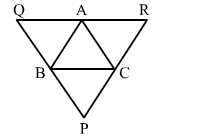In the adjoining figure, ∆ABC is a triangle and through A, B, C, lines are drawn, parallel respectively to BC,
In the adjoining figure, ∆ABC is a triangle and through A, B, C, lines are drawn, parallel respectively to BC, CA and AB, intersecting at P, Q and R. Prove that the perimeter of ∆PQR is double the perimeter of ∆ABC.

Perimeter of ∆ABC = AB + BC + CA ...(i)
Perimeter of ∆PQR = PQ + QR + PR ...(ii)
BC || QA and CA || QB
i.e., BCQA is a parallelogram.
∴ BC = QA ...(iii)
Similarly, BC || AR and AB || CR
i.e., BCRA is a parallelogram.
∴ BC = AR ...(iv)
But, QR = QA + AR
From (iii) and (iv), we get:
⇒ QR = BC + BC
⇒ QR = 2BC
$\therefore B C=\frac{1}{2} Q R$
Similarly, $C A=\frac{1}{2} P Q$ and $A B=\frac{1}{2} P R$
From (i) and (ii), we have:
Perimeter of $\triangle A B C=\frac{1}{2} Q R+\frac{1}{2} P Q+\frac{1}{2} P R$
$=\frac{1}{2}(P R+Q R+P Q)$
i.e., Perimeter of $\triangle A B C=\frac{1}{2}$ (Perimeter of $\triangle P Q R$ )
$\therefore$ Perimeter of $\triangle P Q R=2 \times$ Perimeter of $\triangle A B C$
Click here to get exam-ready with eSaral
For making your preparation journey smoother of JEE, NEET and Class 8 to 10, grab our app now.
